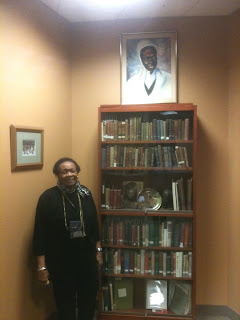 |
| Mahan Hall, U.S. Naval Academy. |
Last week, the Maryland State Archives hosted a War of 1812 workshop for Anne Arundel County Maryland Maryland Maryland
On Saturday, I visited the Sojourner Truth Room, an African American research collection at the Oxon Hill Branch of the Prince George Sojourner Truth Elementary School
 |
| Ms. Ginny Moore standing next to a case of rare books. |
Back to my visit, a friend of mine had met Ginny Moore, the collection’s librarian, at an ALA conference and highly recommended that I meet her when I got to Maryland Maryland
One of the things I miss about being a student is having access to a research library. Therefore, I was thrilled to learn about the varied holdings at the Sojourner Truth Room. Collections include rare 19th century slave narratives, autographed first editions by authors such as Coretta Scott King, the 42-volume set of the WPA Slave Narratives, the Journal of Negro History, a variety of encyclopedias, and scholarly works on African American history and culture. I enjoyed my visit to the Sojourner Truth Room, and look forward to returning!




